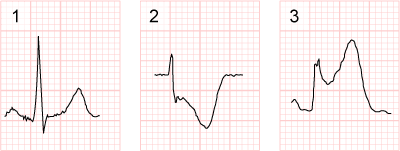Cardiology Teaching Package
A Beginners Guide to Normal Heart Function, Sinus Rhythm & Common Cardiac Arrhythmias
Cardiac Biomarkers
Prior to 2001, technology was such that it was only possible to diagnosis an AMI if there were specific ECG changes (ST segment elevation) and a clear history of cardiac chest pain.
It should be noted that this group of patients (ST segment Elevation) represents only a small proportion of those admitted with cardiac chest pain.
Because CK is released by all injured muscle, not just injured myocardium, the threshold for abnormal CK was very high (250 where normal was as low as 25) and therefore there could be an enormous rise in CK without a diagnosis of AMI.
In 2006 the threshold for abnormal CK was increased to 500
Troponin is released with as little as 1gram of myocardial cell death and it is therefore now possible to diagnose a myocardial infarction of a much smaller size, so small that it does not cause ST segment elevation.
It does, however, cause minor ECG changes previously only associated with unstable angina (ST segment depression). It will also cause a CK rise but often this rise will be within acceptable limits. These are the patients who would previously have been treated as "high-risk" unstable angina.
Image: ST Segment - Normal, Depressed, Elevated

- Diagram 1 shows a normal ST segment
- Diagram 2 shows the ST segment depressed
- Diagram 3 shows the ST segment elevated
It has been estimated that,since the 2001 guidelines were introduced, the number of patients leaving hospital with a diagnosis of MI has increased by more than 50%.
